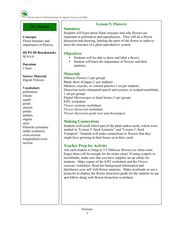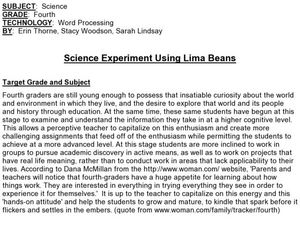Curated OER
Plants
One slide reviews the main plant parts and most of the remaining slides address seven plant processes of life. This is a different approach to introducing the life of a plant. Three tasks are assigned to viewers on the last slide, making...
Curated OER
Parts of a Plant
In this parts of a plant worksheet, 2nd graders write the name of 3 numbered parts of the plant diagram, then color the picture; part names are not given.
Curated OER
Dry Forest: Flowers
Students explore botany by examining diagrams. In this plant reproduction lesson plan, students define a list of plant vocabulary terms and identify plant anatomy from a diagram. Students complete several plant activity worksheets and...
Curated OER
Drawing Plants with Plant Studio Freeware
Students identify parts of plants by name and the relationship among these parts as they use Plant Studio Freeware Wizard and tools on the computer to draw a particular plant from life or from a picture.
Curated OER
Life Cycle of Brassica Plants: Planting Seeds
Learners explore botany by participating in a calendar class activity. In this plant observation lesson, students examine a diagram of a Brassica plant and identify its anatomy before planting their own seeds and viewing the changes over...
Curated OER
Clay Ants: Insect Anatomy
Students examine anatomic structures in order to identify insects from other living organisms. They gain a level of comfort from anxiety when observing and handling live and pinned insects. They create clay models of an insect.
Curated OER
Peanut Anatomy
Students explore the peanut plant. In this peanut lesson, students discuss the needs and parts of regular plants. They research peanut plants to see why they are unique.
Garden Earth Naturalist Club
Parts of a Flower! Flower Dissection
Sometimes the best way to learn about plants is to see the different parts of a plant yourself. Groups of learners dissect flowers to answer questions about what they observe and what they wonder about their flower.
Curated OER
Invent an Insect
Explore biology by researching adaptation. First, learners research and define a list of insect vocabulary terms and discuss the benefits of each insect characteristic. They then utilize a worksheet to create their own insect and share...
Curated OER
Flower Dissection
Students dissect three different flowers and compare and contrast them. In this flowers lesson plan, students learn about the flower anatomy and then dissect their own flowers.
The Science Spot
Flower Basics
Learn about plants and pollination with a worksheet about the parts of a flower. After labeling the anatomy of a flower using a word bank, kids explain the difference between self-pollination and cross-pollination, and unscramble the...
Curated OER
A Botanists View
Students explore plant and seed structure. They dissect a seed and identify its parts. In addition, they explain the function and compare and contrast monocotyledon and dicotlyledons.
Curated OER
Cell Organelles
Students explore biology by researching living cells. In this living organism instructional activity, students participate in a role-playing activity in which all the students in class form one plant cell by portraying specific parts of...
Curated OER
Flower Dissection
Students investigate th anatomy of a flower. They investigate the structures and processes by which flowering plants generate pollen, ovules, seeds, and fruit through dissection,
Curated OER
Arabian Camel or Dromedary
In this camel worksheet, students study the diagram for an Arabian camel otherwise known as a dromedary. Students read the characteristics of the animal and may click on associated links to learn more.
Curated OER
Science Experiment Using Lima Beans
Fourth graders tie together elements about the world and their environment. Students incorporate styles of higher order thinking skills. Students measure skills of observations, conclusions, inferences and predictions.

















